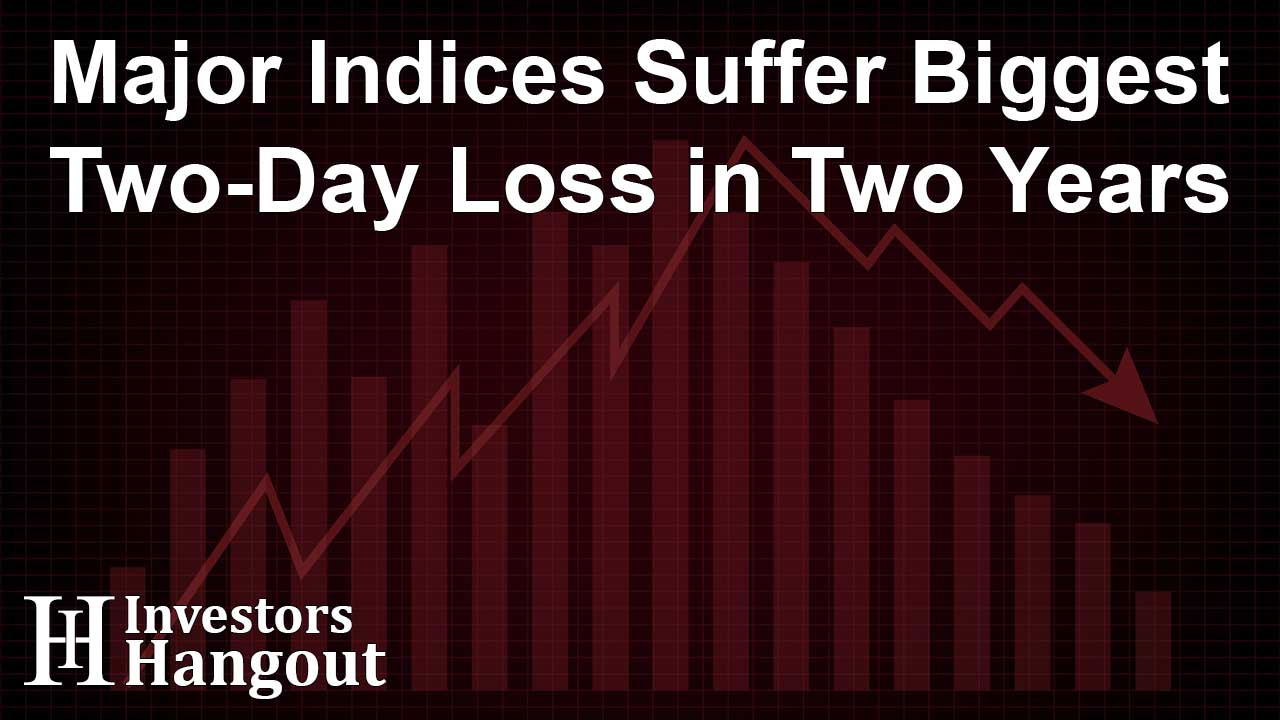Major Indices Suffer Biggest Two-Day Loss in Two Years

U.S. Stocks Plummet for Second Consecutive Session
On Friday, U.S. stocks sold off for a second consecutive session signifying a notable market downturn. Fears of an approaching recession brought on by a less-than-expected jobs report drove this fall. Closing at 39,726.87, the Dow Jones Industrial Average dropped 621.10 points, or 1.54%, With 100.70 points lost—or 1.85%—the S&P 500 came out at 5,345.98 points. To end at 16,773.22 the Nasdaq Composite dropped 417.98 points, or 2.43%. These falls matched a dramatic sell-off in big tech companies like Amazon and Intel. The market responded quickly, and investors started to rethink their approaches. For the S&P 500 as well as the Dow, the two-day slide represented the steepest in almost two years. Added to the uncertainty were questions about the Federal Reserve's next action. Many market players are now getting ready for more volatility. The situation of investor attitude is fragile in the present surroundings.
Nasdaq Composite Enters Correction Territory
Officially falling over 10% from its July closing high, the Nasdaq Composite is in correction territory. This downturn reflects growing worries about tech sector overvaluations. After their quarterly results let down investors, major tech companies including Intel and Amazon saw notable drops. With the Philadelphia SE Semiconductor Index lowest for three months, the sell-off in chip stocks also helped to explain the Nasdaq's decline. This adjustment underlines how sensitive the market is to earnings reports and economic data. The influence of a possible recession on tech values worries investors more and more. The fall has wiped out a good amount of the earlier in the year gains attained. Short term recovery of the Nasdaq is now under doubt by analysts. The correction emphasizes the volatility of the tech-heavy index by nature. Participants in the market are probably going to be cautious until better economic signals arrive.
Weak Jobs Report Sparks Recession Fears
A weaker-than-expected jobs report has raised recessionary worries. The Labor Department noted just 114,000 nonfarm payroll jobs gained last month. This number lagged far behind the 175,000 jobs experts had projected. It also missed the 200,000 jobs required to match population increase. Rising to 4.3%, the unemployment rate was highest in almost three years. These depressing numbers imply that the economy is slowing down more quickly than expected. Nowadays, it seems dubious that the Federal Reserve decided to maintain rates constant at its most recent policy meeting. Investors worry that the Fed cut rates too slowly, waiting too long. The weak jobless numbers also set off the historically accurate recession indicator, the Sahm Rule. This evolution has heightened the anxiety on the market. The statistics has caused a review of the possibilities for economic development.
Labor Department Reports Disappointing Job Growth
With nonfarm payrolls rising by just 114,000 last month, the Labor Department's most recent estimate exposed depressing job growth. This number is much below the average projection of 175,000 jobs made by economists. It also falls short of the 200,000 jobs required to keep pace with population increase. Rising to 4.3%, the unemployment rate peaked almost three years ago. These figures point to a slowing down of the economy and generate questions about possible recession. The results of the report have caused a strong market reaction whereby important indices have dropped. Nowadays, investors are challenging the Federal Reserve's latest choice to maintain constant interest rates. The slow job growth has led to worries about the Fed possibly misjudging the state of the economy. The depressing numbers also set off the Sahm Rule, so supporting recession concerns. This accentuates the general uncertainty of the market. The performance of the labor market will be much under observation in the next months.
Unemployment Rate Climbs to Near Three-Year High
Rising to 4.3%, the unemployment rate is highest it has been in almost three years. This rise corresponds with a slowing down of the economy and heightened recessionary worries. A less-than-expected rise in nonfarm payroll jobs accompanied the rise in unemployment. Just 114,000 jobs were added last month, far less than the expected 175,000 according to the Labor Department. The difficulties in the employment market point to a slowing down of economic growth. This development begs doubts regarding the latest monetary policy choices of the Federal Reserve. Investors worry the Fed might have waited too long to lower rates. The climb in the unemployment rate has also set off the dependable recession indicator, the Sahm Rule. This has accentuated the uncertainty of the market. Future economic assessments will much rely on the performance of the labor market. The existing state of affairs emphasizes the difficulties the economy faces.
Fed's Rate Cut Expectations Surge Amid Economic Concerns
Given poor economic data, expectations for a Federal Reserve rate cut have skyrocket. FedWatch Tool of the CME now shows a 69.5% chance of a 50 basis point rate cut at the September Fed meeting. This is a marked rise from just 22% in the previous session. After a dismal employment report showing just 114,000 nonfarm payroll jobs added last month, expectations have surged. Rising to 4.3%, the unemployment rate also increased recession worries. Following their recent policy meeting, investors are now challenging the Fed's choice to maintain rates unchanged. There is growing worry about the Fed's possible misjudging of the state of the economy. The market responded quickly to the poor job data, with significant indices seeing declines. The market's need for comfort shows in the expectation of a rate cut. Investors will pay great attention to the Fed's next actions. The central bank is under great pressure to boost the national GDP.
Sahm Rule Triggered: A Recession Indicator
The weak jobless report set off the historically accurate recession indicator known as the Sahm Rule. The Sahm Rule indicates a recession when the three-month average unemployment rate increases by 0.5% point or more from its low over the past 12 months. This is satisfied by the recent rise in the unemployment rate to 4.3%. This development has heightened worries about a recession just around around. The accuracy of the Sahm Rule in forecasting economic crises is much appreciated. Its activation implies that the economy might be slowing down faster than earlier believed. Investors are reevaluating their financial situation. The market responded negatively and fast to the triggering of the Sahm Rule. Big indices dropped, reflecting growing recession worries. Now under examination is the Federal Reserve's recent decision to maintain steady rates. The activating of the Sahm Rule emphasizes the difficulties the economy faces. Future economic data will be under close observation in search of more indications of weakness.
Major Indices Suffer Significant Losses
Disappointing economic data caused major losses in some of the main American stock indices. Closing at 39,726.87, the Dow Jones Industrial Average dropped 621.10 points, or 1.54%, With 100.70 points lost—or 1.85%—the S&P 500 came out at 5,345.98 points. To end at 16,773.22 the Nasdaq Composite dropped 417.98 points, or 2.43%. For the S&P 500 and the Dow in almost two years, these falls represented the steepest two-day slide. Rising recession worries and a below-average jobs report drove the sell-off. After their quarterly results let down investors, major tech companies including Amazon and Intel saw notable drops. The response of the market to the economic facts was quick and negative. The major losses show more investor anxiety. The next actions of the Federal Reserve now occupy the center of the market. The current situation emphasizes how delicate investor mood is.
Tech Giants Amazon and Intel Lead Declines
After their underwhelming quarterly results, tech behemoths Amazon and Intel led the stock market declines. After publishing less-than-expected results and offering a wary projection, Amazon's stock fell. Intel's stock price suffered as well since its quarterly performance fell short of expectations. These falls helped to explain the general tech industry sell-off. Highly weighted with tech stocks, the Nasdaq Composite entered correcting ground. The undervaluation in the industry has been brought under question by the disappointing performance of these tech behemoths Investors are reviewing their tech stock positions right now. The falls in Intel and Amazon draw attention to how sensitive the market is to earnings announcements. The challenges of the tech industry have accentuated the general volatility of the market. In the next weeks, the performance of significant tech stocks will be under great attention. Economic data and future earnings reports now dominate the market.
Market Volatility Spikes, VIX Hits Highest Level Since March 2023
Market volatility has surged; the CBOE Volatility Index (VIX) peaked since March 2023. Often referred to as Wall Street's "fear gauge," the VIX crossed its long-term average of 20 points to reach 29.66. This rise in volatility reflects growing investor nervousness in face of unsatisfactory economic data. The unstable market has resulted from the poor jobs report and growing recession concerns. Notable indices including the Nasdaq Composite, S&P 500, and Dow fell significantly. The response of the market to the economic facts was quick and unfavorable. The VIX surge points to a great degree of investor ambiguity. Some market players see the sell-off as a chance to get stocks at less expensive rates. According to UBS strategist Jonathan Golub, extended VIX results often produce best market returns. The situation of today emphasizes the difficulties investors face. Future market movements will be closely observed in search of indicators of consistency.
About The Author
Contact Addison Perry privately here. Or send an email with ATTN: Addison Perry as the subject to contact@investorshangout.com.
About Investors Hangout
Investors Hangout is a leading online stock forum for financial discussion and learning, offering a wide range of free tools and resources. It draws in traders of all levels, who exchange market knowledge, investigate trading tactics, and keep an eye on industry developments in real time. Featuring financial articles, stock message boards, quotes, charts, company profiles, and live news updates. Through cooperative learning and a wealth of informational resources, it helps users from novices creating their first portfolios to experts honing their techniques. Join Investors Hangout today: https://investorshangout.com/
